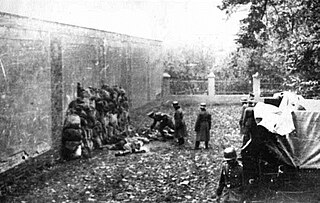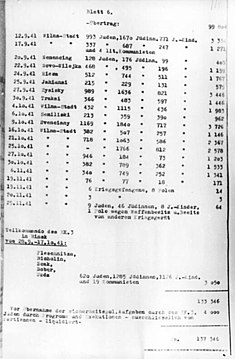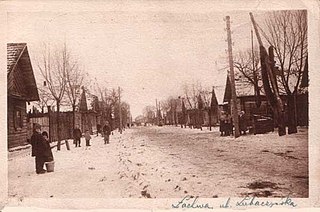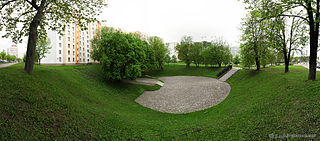 W
WThe Holocaust in Belarus is the term that refers to the systematic discrimination and extermination of Jews living in the former Byelorussian Soviet Socialist Republic which was occupied by Nazi Germany after August 1941 during World War II. American historian Lucy Dawidowicz, author of The War Against the Jews estimated that 66% of the Jews residing in Byelorussian SSR died in the Holocaust, out of 375,000 Jews in Byelorussia prior to World War II according to Soviet data. By comparison, in the Baltic states about 90% of Jews were killed in the same period.
 W
WThe Basilian Church of St Peter and Paul and Monastery in Berezwecz was a historic sacred structure in what is today Hlybokaye, Belarus. The church and monastery began with a foundation in 1637 by Joseph Korsak, the voivode of Mścisław. Run by the Order of Saint Basil the Great, the church and monastery were rebuilt in 1750-67 according to a design by Johann Christoph Glaubitz. A widely admired example of Vilnian Baroque the structure's facade was constructed of nine convex and eight concave surfaces.
 W
WThe Blue Police, was the police during the Second World War in German-occupied Poland. The entity's official German name was Polnische Polizei im Generalgouvernement.
 W
WThe Byelorussian Auxiliary Police was a collaborationist paramilitary force established in July 1941. Staffed by local inhabitants from German-occupied Byelorussia, it had similar functions to those of the German Ordnungspolizei in other occupied territories.
 W
WThe Dzyatlava massacres were two consecutive mass shooting actions carried out three months apart during the Holocaust. The town of Zdzięcioł was located in the Nowogródek Voivodeship of the Second Republic prior to World War II.
 W
WEinsatzgruppen were Schutzstaffel (SS) paramilitary death squads of Nazi Germany that were responsible for mass killings, primarily by shooting, during World War II (1939–1945) in German-occupied Europe. The Einsatzgruppen had an integral role in the implementation of the so-called "Final Solution to the Jewish Question" in territories conquered by Nazi Germany, and were involved in the murder of much of the intelligentsia and cultural elite of Poland, including members of the Catholic priesthood. Almost all of the people they killed were civilians, beginning with the intelligentsia and swiftly progressing to Soviet political commissars, Jews, and Romani people, as well as actual or alleged partisans throughout Eastern Europe.
 W
WThe Einsatzgruppen Operational Situation Reports (OSRs), or ERM for the German: Die Ereignismeldung UdSSR, were dispatches of the Nazi death squads (Einsatzgruppen), which documented the progress of the Holocaust behind the German-Soviet frontier in the course of Operation Barbarossa, during World War II. The extant reports were sent between June 1941 and April 1942 to the Chief of the Security Police and the SD in Berlin, from the occupied eastern territories including modern-day Poland, Belarus, Ukraine, Russia, Moldova, and the Baltic Countries. During the Nuremberg War Crimes Trials the originals were grouped according to year and month and catalogued using a consecutive numbering system, as listed in the below table. The original photostats are held at the National Archives in Washington D.C..
 W
WDuring World War II, the Nazi German Einsatzkommandos were a sub-group of the Einsatzgruppen – up to 3,000 men total – usually composed of 500–1,000 functionaries of the SS and Gestapo, whose mission was to exterminate Jews, Polish intellectuals, Romani, and communists in the captured territories often far behind the advancing German front. Einsatzkommandos, along with Sonderkommandos, were responsible for the systematic killing of Jews during the aftermath of Operation Barbarossa, the invasion of the Soviet Union. After the war several commanders were tried in the Einsatzgruppen trial, convicted, and executed.
 W
WThe Generalplan Ost, abbreviated GPO, was the Nazi German government's plan for the genocide and ethnic cleansing on a vast scale, and colonization of Central and Eastern Europe by Germans. It was to be undertaken in territories occupied by Germany during World War II. The plan was attempted during the war, resulting indirectly and directly in the deaths of millions by shootings, starvation, disease, extermination through labor, and genocide. But its full implementation was not considered practicable during the major military operations, and was prevented by Germany's defeat.
 W
WHitler’s Bandit Hunters: The SS and the Nazi Occupation of Europe is a 2006 book by the British author and researcher Philip W. Blood. It discusses the evolution of German rear security policies during World War II, from Partisanenkreig to Bandenbekämpfung, leading to mass crimes against humanity and genocide.
 W
WThe so-called Jäger Report, also Jaeger Report was written on 1 December 1941 by Karl Jäger, commander of Einsatzkommando 3, a killing unit of Einsatzgruppe A which was attached to Army Group North during the Operation Barbarossa. It is the most detailed and precise surviving chronicle of the activities of one individual Einsatzkommando, and a key record documenting the Holocaust in Lithuania as well as in Latvia and Belarus.
 W
WKhatyn was a village of 26 houses and 157 inhabitants in Belarus, in Lahoysk Raion, Minsk Region, 50 km away from Minsk. On 22 March 1943, almost the entire population of the village was massacred by the Schutzmannschaft Battalion 118 in retaliation for an attack on German troops by Soviet partisans. The battalion was composed of Nazi collaborators and assisted by the Dirlewanger Waffen-SS special battalion.
 W
WLakhva is a small town in southern Belarus, with a population of approximately 2,100. Lakhva is considered to have been the location of one of the first, if not the first, Jewish ghetto uprisings of the Second World War.
 W
WLatvian Auxiliary Police was a paramilitary force created from Latvian volunteers by the Nazi German authorities who occupied the country in June 1941. It was part of the Schutzmannschaft (Shuma), native police forces organized by the Germans in occupied territories and subordinated to the Order Police. Some units of the Latvian auxiliary police were involved in the Holocaust. One of its units, the Arajs Kommando, was notorious for killing 26,000 civilians during the war, mostly Jews, but also Communists and Romas.
 W
WMarching into Darkness: The Wehrmacht and the Holocaust in Belarus is a book by the American historian Waitman Wade Beorn, published in 2014 by Harvard University Press. It discusses the participation of the German Wehrmacht in the Holocaust and other crimes against humanity during the course of the early stages of the German-Soviet War (1941–45).
 W
WThe Minsk Trial was a war crimes trial held in front of a Soviet military tribunal in 1946 in Minsk, the capital of Soviet Belarus. Defendants included German military, police, and SS officials who were responsible for implementing the occupational policies in Belarus during the German–Soviet War of 1941–45.
 W
WThe Order Police battalions were militarised formations of the German Order Police during the Nazi era. During World War II, they were subordinated to the SS and deployed in German-occupied areas, specifically the Army Group Rear Areas and territories under German civilian administration. Alongside detachments from the Einsatzgruppen and the Waffen-SS, these units perpetrated mass murder of the Jewish population and were responsible for large-scale crimes against humanity targeting civilian populations.
 W
WThe Pit is a monument dedicated to the victims of the Holocaust on the corner of Melnikayte and Zaslavskaya streets in Minsk, Belarus. The memorial is located at the site where on March 2, 1942, the Nazi forces shot about 5,000 Jewish residents of the nearby Minsk Ghetto.
 W
WThe Police Regiment Centre was a formation of the Order Police during the Nazi era. During Operation Barbarossa, it was subordinated to the Schutzstaffel (SS) and deployed in German-occupied areas, specifically the Army Group Centre Rear Area, of the Soviet Union. In mid-1942, its three constituent battalions were reassigned and the unit was re-designated as the 13th Police Regiment.
 W
WSchutzmannschaft-Brigade Siegling was a Belarusian Auxiliary Police brigade formed by Nazi Germany in July 1944 in East Prussia, from members of six local volunteer battalions of Schutzmannschaft following the Soviet Operation Bagration. The six retreating collaborationist units who joined Siegling included Bataillon 57 (ukrainische), Bataillon 60 (weißruthenische), Bataillon 61, 62, 63 (ukrainische), and Bataillon 64 (weißruthenische).
 W
WThe Severity Order or Reichenau Order was the name given to an order promulgated within the German Sixth Army on the Eastern Front during World War II by Generalfeldmarschall Walther von Reichenau on 10 October 1941.
 W
WThe Slutsk affair refers to the massacre of thousands of Jews and others that occurred in Slutsk, Belarus in the Soviet Union, in October 1941, near the city of Minsk while under German occupation during World War II. The perpetrators were a combination of Gestapo special forces and Lithuanian allies of the Third Reich. Nearly 4,000 Jews were murdered over a two-day period along with thousands of non-Jews.
 W
WSonderaktion 1005, also called Aktion 1005, or Enterdungsaktion, began in May 1942 during World War II to hide any evidence that people had been murdered by Nazi Germany in German-occupied Poland and Soviet Union. The project, which was conducted in secrecy from 1942 to 1944, focused on concealing evidence of mass murder at the Operation Reinhard killing centres, as well as at other sites. Groups of Sonderkommando prisoners, officially called Leichenkommandos, were used to exhume mass graves and burn the bodies; inmates were often put in chains to prevent them from escaping.